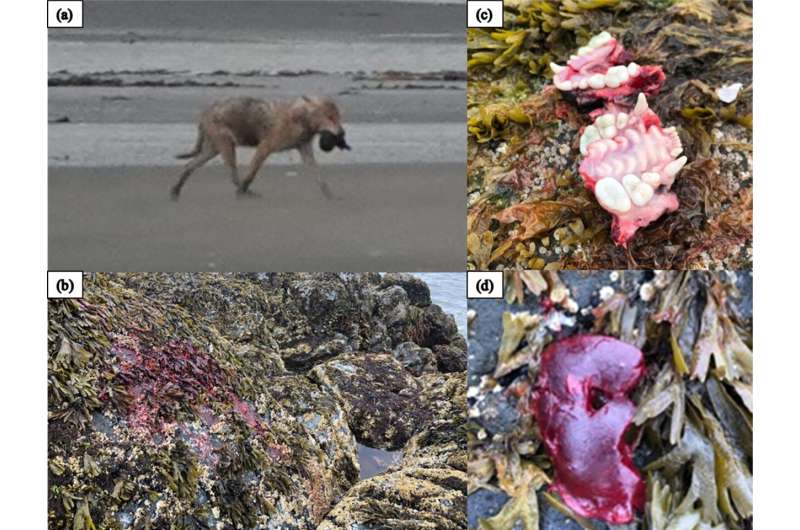This article has been reviewed according to Science X's editorial process and policies. Editors have highlighted the following attributes while ensuring the content's credibility:
fact-checked
peer-reviewed publication
trusted source
proofread
Researchers observe wolves hunting and killing sea otters and harbor seals on Alaska's Katmai coast

Firsthand observations of a wolf hunting and killing a harbor seal and a group of wolves hunting and consuming a sea otter on Alaska's Katmai coast have led scientists to reconsider assumptions about wolf hunting behavior.
Wolves have previously been observed consuming sea otter carcasses, but how they obtain these and the frequency of scavenging versus hunting marine prey is largely unknown. Scientists at Oregon State University, the National Park Service and Alaska Department of Fish and Game are beginning to change that with a paper published in Ecology.
In the paper, they describe several incidents they observed involving wolves and marine mammals in Katmai National Park that they believe haven't been previously documented:
- In 2016 the researchers witnessed a male wolf hunt and kill a harbor seal. The wolf was positioned near the mouth of a creek when it charged into the water, grabbing the tail of the harbor seal. The wolf continued to tear into the flesh of the seal's tail and after an approximate 30-minute struggle, the seal appeared to tire, straining to lift its head above water. The wolf dragged the seal onto the exposed sandbar and began to tear into the existing wound and consume the tail.
- On three separate days in 2016, 2018 and 2019 the scientists and others observed wolves carrying sea otter carcasses.
- In 2021, the researchers watched three wolves hunt and eat an adult sea otter on an island during a low tide. They watched the wolves travel to the island, then lost sight of them for about one minute and then saw them reappear carrying a limp sea otter. They fed on the carcass for about 60 minutes. Once the wolves left, the researchers examined the kill site and found an area of concentrated blood where the sea otter was likely killed. The presence of blood indicates the sea otter had been alive when ambushed by the wolves, as opposed to being scavenged, the researchers note.
"This is really exciting documentation of behaviors we believe have never been directly observed by scientists," said Ellen Dymit, a doctoral student at Oregon State. "It kind of forces us to reconsider the assumptions that underlie a lot of our management decisions and modeling around wolf populations and populations of their prey, which often assume that wolves depend on ungulates, like moose and elk."
The research project originated in 2016 when Kelsey Griffin, a National Park Service biologist, and some of her colleagues stopped for lunch on the beach during a day of conducting marine debris and bird mortality surveys at Katmai National Park.
"Seemingly out of nowhere, we are sitting there, we just see this white wolf carrying an otter just trotting by," Griffin said. "What? I was just blown away. I have never seen anything like that before.
"Then I was asking my co-workers: 'Has anyone seen this before? Do wolves often eat sea otters?' I was just asking a bunch of questions about the wolves and it just seemed like there was not a whole lot of information about them. That was the initial observation. I just got lucky. Wolves on the Katmai coast have never been studied and our research highlights the unique role wolves play in nearshore ecosystems in Alaska."
Griffin connected with Gretchen Roffler, a biologist with Alaska Department of Fish and Game, who introduced Griffin to Taal Levi, a professor at Oregon State and Dymit's advisor.
The project builds on work by Roffler, Levi and others on wolves and sea otters on Pleasant Island, an island landscape adjacent to Glacier Bay about 40 miles west of Juneau and hundreds of miles east of Katmai across the Gulf of Alaska.
In a paper published earlier this year, they found wolves on Pleasant Island caused a deer population to plummet and switched to primarily eating sea otters in just a few years. They believe this is the first case of sea otters becoming the primary food source for a land-based predator.
Future papers will include analysis of wolves and sea otters from Lake Clark National Park, Glacier Bay National Park and Kenai Fjords National Park, in addition to Katmai. The research team plans to look at how sea otter density impacts the diets of wolves and variations of wolf diet on a pack level versus and individual level.
More information: Kelsey R. Griffin et al, Wolves on the Katmai coast hunt sea otters and harbor seals, Ecology (2023). DOI: 10.1002/ecy.4185
Journal information: Ecology
Provided by Oregon State University



















